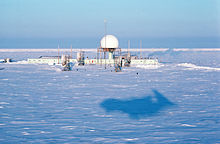AN/FPS-19
 The FPS-19's radome dominates this image of the POW-2 DEW station. | |
| Country of origin | US |
|---|---|
| Manufacturer | Raytheon |
| Introduced | 1953 |
| No. built | ~35 |
| Type | early warning |
| Frequency | L-band, 1220 to 1350 MHz |
| PRF | 400 pps |
| Pulsewidth | 6 μS |
| Range | 160 mi (260 km) |
| Diameter | 75 ft (23 m) |
| Azimuth | 360º |
| Power | 500 kW x 2 |
The AN/FPS-19 was a long-range search radar developed for the NORAD Distant Early Warning Line (DEW Line) by Raytheon. It was an L-band system working between 1220 to 1350 MHz produced by a 500 kW magnetron. Two such systems were placed back-to-back, one with an antenna that produced a narrow beam to improve range for long-range detection, and the second with a wider fan-shaped beam to cover higher angles at shorter ranges. The former could detect bomber-sized targets to about 160 miles (260 km) and the latter covered up to 65,000 ft altitude.
The system was developed from the AN/TPS-1, which dated to the late World War II era. Raytheon adapted it to the long-range role by designing much larger antenna systems and other modifications. The first examples activated in 1957, along with the AN/FPS-23 radars that provided low-altitude coverage between the stations. The AN/FPS-23 were removed in 1963, and the FPS-19's were scheduled to be replaced by the somewhat more powerful AN/FPS-30. The declining role of bomber defense in the era of the intercontinental ballistic missile (ICBM) meant these upgrades were not carried out. The FPS-19 remained in service until the late 1980s, when they were replaced by the AN/FPS-117 as part of the newly-named North Warning System.
The UK equivalent was the AMES Type 80, a significantly more powerful radar that formed the basis of their post-ROTOR network.
References
![]() This article incorporates public domain material from the Air Force Historical Research Agency
This article incorporates public domain material from the Air Force Historical Research Agency
External links
